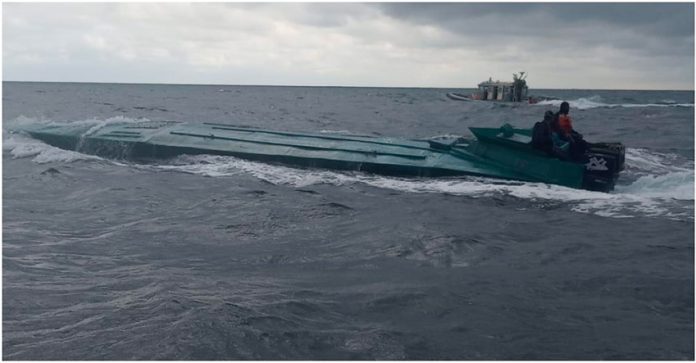Colombian anti-drug police have seized a semi-submersible narco-submarine they say belongs to the Jalisco New Generation Cartel (CJNG) and was headed to Mexico.
On board was more than a tonne of cocaine valued at US $18.6 million, officials in Bogotá said on Monday.
Colombia’s anti-narcotics police and the navy intercepted the vessel 46 nautical miles off the coast of Tumaco, Nariño. Three men were arrested.
Officials said “this semi-submersible, which would have an approximate cost of $1.2 million, has a cargo capacity of up to three tonnes and has a satellite navigation system that, according to the investigations, would allow it to reach its destination in Costa Careyes in the Mexican state of Jalisco by the first week of September.”
Narco-submarines are rarely fully submersible but designed to run so low in the water that they are difficult to detect.
Intelligence and investigations by Colombia’s National Police during what was deemed “Operation Triton” revealed that the shipment was the property of the Colombian criminal syndicate E-30, which is suspected of mass murders and forced displacements in the area, and was destined for the CJNG.
The Mexican cartel has long been tied to Colombia, the world’s leading producer and exporter of cocaine to America, Europe, Asia and Africa. They are particularly associated with the National Liberation Army (ELN), a communist guerrilla movement engaged in cocaine production, international drug smuggling and money laundering which has in the past offered protection to cocaine shipments traveling north.
Colombian police and military authorities told the newspaper El Universal that there is an incessant deployment of Mexican drug traffickers in Colombia, Ecuador, Peru and Central America to direct the production, transportation, distribution and commercialization of cocaine in small and large shipments.
While fast boats were once the preferred vehicle for moving drugs into the United States, methods of detection by law enforcement have improved, and cartels have been forced to get creative.
The first drug-laden submarine was discovered off the coast of Costa Rica in 2006, and over the years they have grown more sophisticated and some even have the capacity to be truly submersible and cross the Atlantic Ocean.
The largest shipment ever seized from a narco-submarine occurred in 2015. It was carrying 7.7 tonnes of cocaine.
In December 2019, a submarine bound for Mexico carrying over a tonne of cocaine was intercepted off the coast of Peru. In May of this year, U.S. authorities seized three semi-submersible submarines over the course of just four days.
Source: El Universal (sp), Seguimiento (sp)
